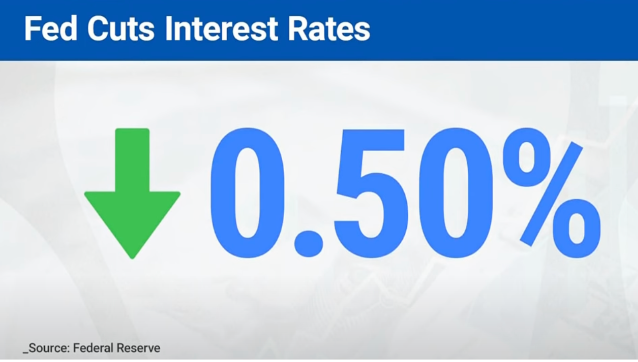News
The Federal Reserve’s Half-Point Interest Rate Cut: What It Means For Your Finances

Source: YouTube
In a significant move to stabilize the U.S. economy, the Federal Reserve has reduced its key interest rate by half a percentage point. This decision is aimed at preventing a potential economic downturn, particularly as the labor market shows signs of cooling. For consumers, this interest rate cut brings changes that could impact everything from car loans and credit cards to mortgages and savings. Let’s dive into what this interest rate reduction means for your financial situation.
The central bank’s decision to cut interest rates by 50 basis points reflects a strategic move aimed at ensuring a “soft landing” for the U.S. economy. Powell emphasized that the half-point cut is part of a broader risk management approach designed to safeguard the labor market and limit the chances of a downturn, especially as job growth slows. While inflation has cooled to near the Fed’s 2% target, the labor market's weakening prompted the Fed to take stronger action to preserve economic stability without overcommitting to further aggressive cuts.
What the Interest Rate Cut Means for Your Auto Loan, Credit Card Debt, and Mortgage
As the Fed lowers the interest rate, the cost of borrowing for car loans and credit cards is expected to decrease. Although the drop in rates might not be immediate, over time, it could ease financial pressure on those looking to purchase a vehicle or carry a credit card balance. The average interest rate for new car loans was hovering around 7.1%, but with the recent rate cut, consumers may see more favorable terms as the year progresses. Credit cards, which typically have interest rates above 22%, could also become slightly less expensive for borrowers, though much depends on the card issuer and the consumer’s credit score.
The Federal Reserve’s interest rate cut could provide a small reprieve for homebuyers, but it won't necessarily solve the housing affordability problem. Mortgage rates, particularly for 30-year fixed loans, are influenced by factors beyond the Fed’s decisions, such as the yield on 10-year Treasury bonds. However, the interest rate reduction could still contribute to lower mortgage rates, which recently stood at 6.2%. Adjustable-rate mortgages (ARMs) and home-equity lines of credit (HELOCs), which are more directly linked to the Fed’s actions, are likely to see a quicker decrease in rates, offering potential savings for homeowners looking to refinance or access equity.
Lower Yields Ahead for Savings Accounts and CDs, Mixed Impact on Student Loans
While borrowers stand to gain from the Federal Reserve's interest rate cut, savers may see less favorable outcomes. Banks tend to lower the interest rate they offer on savings accounts and certificates of deposit (CDs) following a Fed rate cut. This means that individuals relying on high-yield savings accounts might notice a decline in their returns. If you're looking to lock in a decent CD rate, now may be the time before further cuts reduce your earnings potential.
For those with federal student loans, the interest rate cut won’t make an immediate difference, as these loans have fixed rates. However, for borrowers with private student loans, the story is different. Private loans often have variable interest rates, and with the Fed’s recent cut, these rates could drop, providing a potential opportunity to refinance at a lower interest rate.
Market Expectations: More Rate Cuts to Come?
As the Federal Reserve makes its move to lower the interest rate by 50 basis points, investors are already speculating about what comes next. Market analysts predict that additional rate cuts may be on the horizon, with another 70 basis points of reductions anticipated by the end of the year. Jerome Powell, the Fed's chair, emphasized the importance of flexibility, indicating that future interest rate decisions will depend on how the economy performs over the next few months. If the labor market continues to weaken, more aggressive cuts could follow, but the Fed will be closely monitoring inflation and employment data before making any further moves.
How will you take advantage of the Federal Reserve’s interest rate cuts? Tell us what you plan to do!



